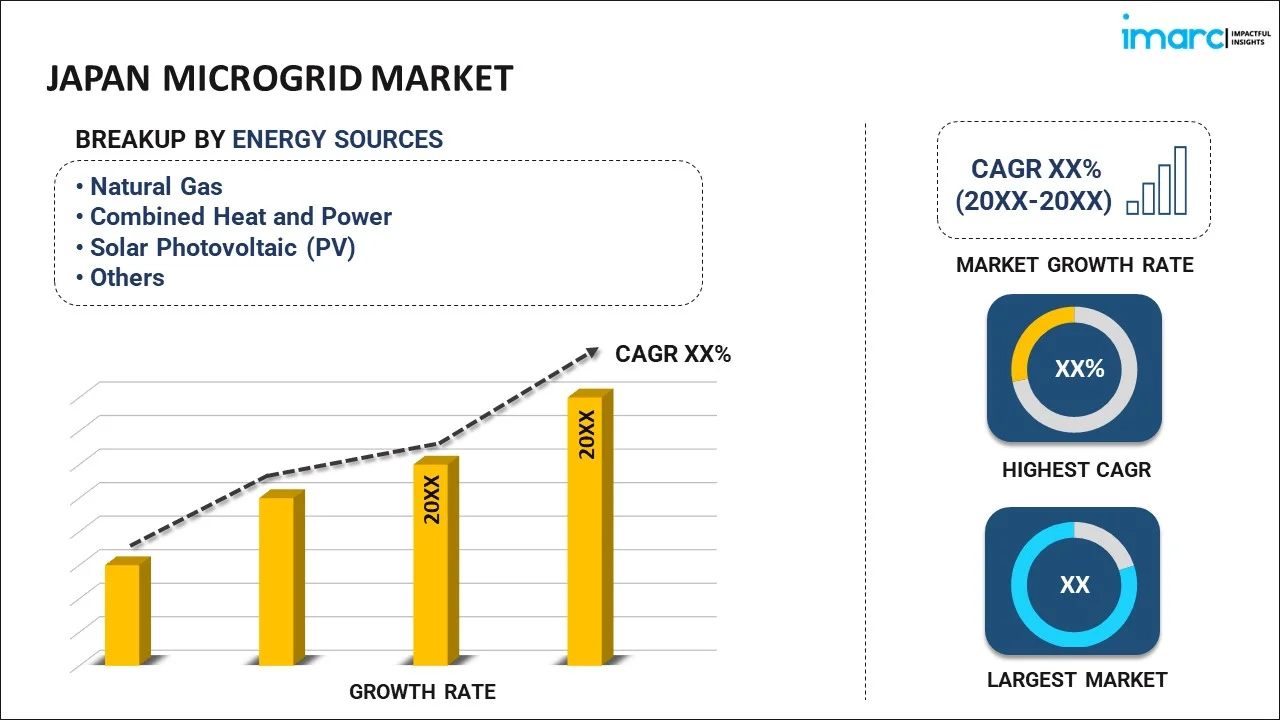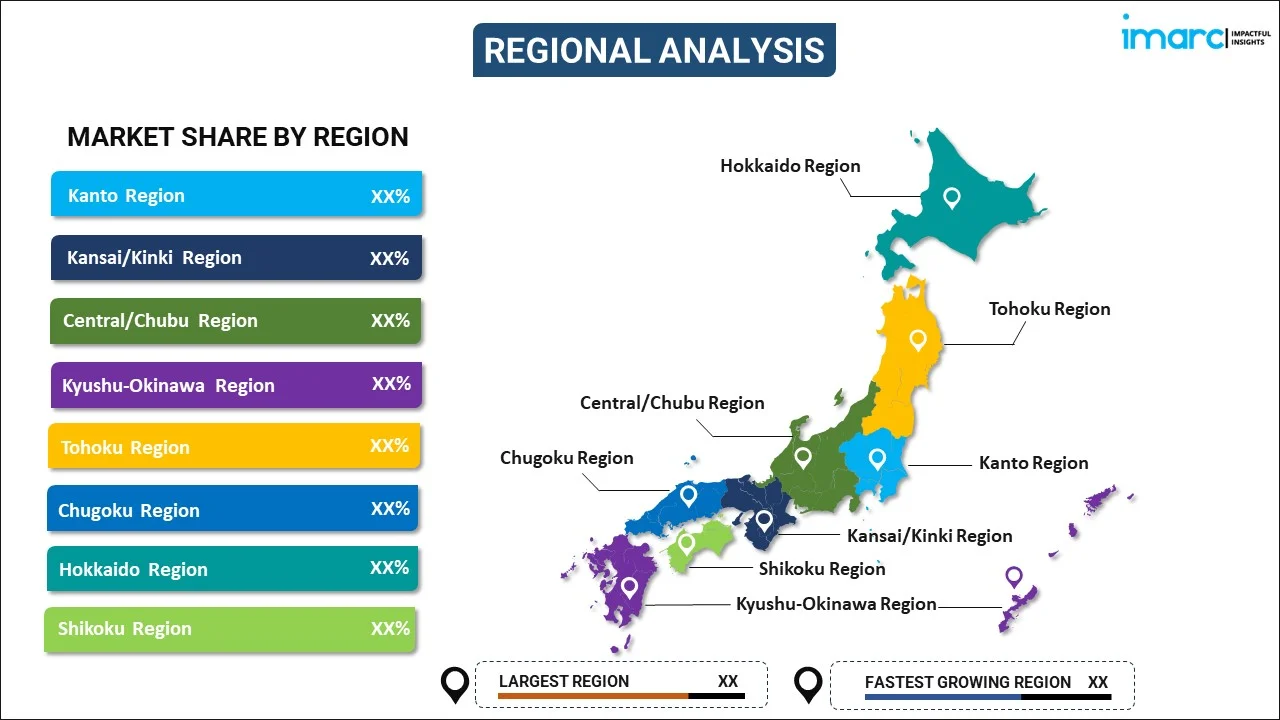
Japan Microgrid Market Report by Energy Source (Natural Gas, Combined Heat and Power, Solar Photovoltaic (PV), Diesel, Fuel Cell, and Others), Application (Remote Systems, Institution and Campus, Utility/Community, Defense, and Others), and Region 2025-2033
Market Overview:
Japan microgrid market size reached USD 2.0 Billion in 2024. Looking forward, IMARC Group expects the market to reach USD 7.8 Billion by 2033, exhibiting a growth rate (CAGR) of 15.68% during 2025-2033. The market is being driven by several key factors, including the increasing need for improved energy security, a growing demand for dependable power, a rising interest in cleaner and more sustainable energy options, and a greater need for cost-efficient energy systems.
|
Report Attribute
|
Key Statistics
|
|---|---|
|
Base Year
|
2024 |
|
Forecast Years
|
2025-2033 |
|
Historical Years
|
2019-2024
|
| Market Size in 2024 | USD 2.0 Billion |
| Market Forecast in 2033 | USD 7.8 Billion |
| Market Growth Rate (2025-2033) | 15.68% |
A microgrid is a compact energy system designed to generate, distribute, and oversee electricity either on its own or in coordination with the primary power grid. Typically, it incorporates a mix of renewable energy sources, energy storage units, and traditional generators. This system has the capability to function independently or detach itself from the main grid in situations like power failures or emergencies, ensuring a consistent and dependable power source for a particular region or facility. Due to its adaptability and ability to be tailored to specific energy requirements, there is a rising interest in microgrids.
Japan Microgrid Market Trends:
The microgrid market in Japan is experiencing significant growth and development. With a strong emphasis on energy security, sustainability, and innovation, Japan has become a thriving hub for microgrid technology. The country's susceptibility to natural disasters, such as earthquakes and tsunamis, has spurred a greater need for reliable and resilient energy solutions. Microgrids, with their ability to operate autonomously during power outages or emergencies, are seen as a crucial component of Japan's energy landscape. Additionally, Japan's commitment to reducing its carbon footprint and transitioning towards cleaner energy sources has further boosted the adoption of microgrids, which often incorporate renewable energy technologies. As a result, the Japan microgrid market is poised for continued expansion as it addresses the nation's energy security and sustainability objectives. In accordance with this, microgrids enable institutions to produce electricity on a localized scale, enhancing cost-effectiveness by reducing the dependence on costly grid electricity purchases. Through the effective utilization of renewable energy resources, in conjunction with energy storage and streamlined demand management, these systems can substantially decrease operational expenses. Furthermore, for scenarios where electricity is required in remote or off-grid settings, like mining operations or rural areas, microgrids offer an economical and eco-friendly means of obtaining power, eliminating the necessity for expensive long-distance power transmission infrastructure. This situation is expected to contribute to a favorable market outlook over the forecasted period.
Japan Microgrid Market Segmentation:
IMARC Group provides an analysis of the key trends in each segment of the market, along with forecasts at the country level for 2025-2033. Our report has categorized the market based on energy source and application.
Energy Source Insights:

- Natural Gas
- Combined Heat and Power
- Solar Photovoltaic (PV)
- Diesel
- Fuel Cell
- Others
The report has provided a detailed breakup and analysis of the market based on the energy source. This includes natural gas, combined heat and power, solar photovoltaic (PV), diesel, fuel cell, and others.
Application Insights:
- Remote Systems
- Institution and Campus
- Utility/Community
- Defense
- Others
A detailed breakup and analysis of the market based on the application have also been provided in the report. This includes remote systems, institution and campus, utility/community, defense, and others.
Regional Insights:

- Kanto Region
- Kansai/Kinki Region
- Central/ Chubu Region
- Kyushu-Okinawa Region
- Tohoku Region
- Chugoku Region
- Hokkaido Region
- Shikoku Region
The report has also provided a comprehensive analysis of all the major regional markets, which include Kanto Region, Kansai/Kinki Region, Central/ Chubu Region, Kyushu-Okinawa Region, Tohoku Region, Chugoku Region, Hokkaido Region, and Shikoku Region.
Competitive Landscape:
The market research report has also provided a comprehensive analysis of the competitive landscape in the market. Competitive analysis such as market structure, key player positioning, top winning strategies, competitive dashboard, and company evaluation quadrant has been covered in the report. Also, detailed profiles of all major companies have been provided.
Japan Microgrid Market Report Coverage:
| Report Features | Details |
|---|---|
| Base Year of the Analysis | 2024 |
| Historical Period | 2019-2024 |
| Forecast Period | 2025-2033 |
| Units | Billion USD |
| Scope of the Report | Exploration of Historical and Forecast Trends, Industry Catalysts and Challenges, Segment-Wise Historical and Predictive Market Assessment:
|
| Energy Sources Covered | Natural Gas, Combined Heat and Power, Solar Photovoltaic (PV), Diesel, Fuel Cell, Others |
| Applications Covered | Remote Systems, Institution and Campus, Utility/Community, Defense, Others |
| Regions Covered | Kanto Region, Kansai/Kinki Region, Central/ Chubu Region, Kyushu-Okinawa Region, Tohoku Region, Chugoku Region, Hokkaido Region, Shikoku Region |
| Customization Scope | 10% Free Customization |
| Post-Sale Analyst Support | 10-12 Weeks |
| Delivery Format | PDF and Excel through Email (We can also provide the editable version of the report in PPT/Word format on special request) |
Key Questions Answered in This Report:
- How has the Japan microgrid market performed so far and how will it perform in the coming years?
- What has been the impact of COVID-19 on the Japan microgrid market?
- What is the breakup of the Japan microgrid market on the basis of energy source?
- What is the breakup of the Japan microgrid market on the basis of application?
- What are the various stages in the value chain of the Japan microgrid market?
- What are the key driving factors and challenges in the Japan microgrid?
- What is the structure of the Japan microgrid market and who are the key players?
- What is the degree of competition in the Japan microgrid market?
Key Benefits for Stakeholders:
- IMARC’s industry report offers a comprehensive quantitative analysis of various market segments, historical and current market trends, market forecasts, and dynamics of the Japan microgrid market from 2019-2033.
- The research report provides the latest information on the market drivers, challenges, and opportunities in the Japan microgrid market.
- Porter's five forces analysis assist stakeholders in assessing the impact of new entrants, competitive rivalry, supplier power, buyer power, and the threat of substitution. It helps stakeholders to analyze the level of competition within the Japan microgrid industry and its attractiveness.
- Competitive landscape allows stakeholders to understand their competitive environment and provides an insight into the current positions of key players in the market.
Need more help?
- Speak to our experienced analysts for insights on the current market scenarios.
- Include additional segments and countries to customize the report as per your requirement.
- Gain an unparalleled competitive advantage in your domain by understanding how to utilize the report and positively impacting your operations and revenue.
- For further assistance, please connect with our analysts.
 Inquire Before Buying
Inquire Before Buying
 Speak to an Analyst
Speak to an Analyst
 Request Brochure
Request Brochure
 Request Customization
Request Customization




.webp)




.webp)












